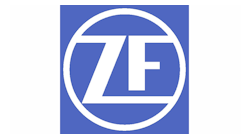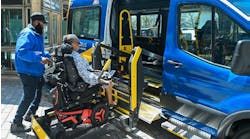To combat the increasing mobility requirements in rapidly growing major cities, public transportation has to carry increasing numbers of people in shorter turnaround times. Today's transit operators and city planners are therefore increasingly embracing the bus rapid transit (BRT) concept.
“ZF low-floor technology is a central element in implementing BRT systems. The use of low-floor buses dispenses with the need for building special BRT platform stops which require extensive planning and prove expensive,” explained Andreas Moser, head of the Axle & Transmission Systems for Buses & Coaches business unit at ZF Friedrichshafen AG. “Extending the system that optimizes transportation also proves more flexible, as low-floor buses can also be used efficiently wherever no BRT infrastructure has been set up.”
Low-floor buses facilitate level boarding — a feature that promotes high passenger comfort. The continuous level center aisle with no disruptive platforms also increases the flow of people as well as passenger safety in the bus.
Transport operators also benefit from shorter stopping times at bus stops and from faster round-trip times thanks to the level boarding and alighting.
AV 133: New Generation of the ZF Low-Floor Bus Axle
ZF will be rolling out a new axle generation for low-floor buses in two stages. Important modifications were made to the advanced driven axle back in 2011. Thanks to integration of functions for consoles and screw connections, the AV 133 will already be much lighter yet provide increased performance compared with the AV 132.
In addition, the optional aluminum spring carriers alone provide for weight savings of 45 kilograms which corresponds to an improvement of around 5 percent. Thus, the new low-floor chassis system including air springs, shock absorbers and control arms weighs just 938 kilograms. With new emissions standards or driveline electrification, ZF has managed to compensate for that additional vehicle weight.
“By the end of 2015, the second stage will take place in close cooperation with the customers. Here, the focus will be on the further improvement of efficiency, noise level and weight,” said Andreas Moser. “Only once this has been successfully completed will the AV 133 lettering be stamped on the type plates.”
Today, the new low-floor portal axle already makes heavy-duty applications easier — for instance for double-articulated buses — since it is designed for higher torques. This is achieved by specifically reinforcing the gearings and bearings, as well as the differential. The new axle comes with the same connection points as the AV 132 and can be easily integrated into existing vehicle platforms.
New RL 82 EC Independent Suspension for Higher Axle Loads
The further developed RL 82 EC low-floor front axle is also an answer to increasing weight due to the greater requirements associated with emission standards or through driveline electrification. ZF has adjusted the RL 75 EC independent suspension through design changes and by using high-strength steel. The load at the front axle thus increased by up to 700 kg to a maximum of 8.2 tons. However, the installation space and the used wheel and tire sizes do not change; the new RL 82 EC independent suspension fits into all vehicle models that before have been on the road with the RL 75 EC.
Greater Maneuverability With Lower Weight: RL 55 EC Independent Suspension for Midibuses
In inner-city traffic with narrow passages and high vehicle density, shorter buses play an ever more important role. “The higher requirements for technology, handling, safety and comfort of midibuses demanded a new axle concept and we responded to this demand with our RL 55 EC,” said Andreas Moser.
The RL 55 EC independent suspension's design allows for use in vehicles with a conventional high floor but also with a front-end section in full low-floor design. In terms of fuel savings, the RL 55 EC independent suspension can also score as it is lighter compared to the solid axle.
With a strong wheel deflection of 55 degrees at the inner wheel and 45 degrees at the outer wheel, the RL 55 EC independent suspension substantially reduces the turning circle compared with a solid axle. At the same time, it offers excellent roll stiffness for a possible axle load of up to 5.8 tons — even without stabilizer. To have maximum engineering freedom for the chassis, the RL 55 EC features a particularly compact design.




